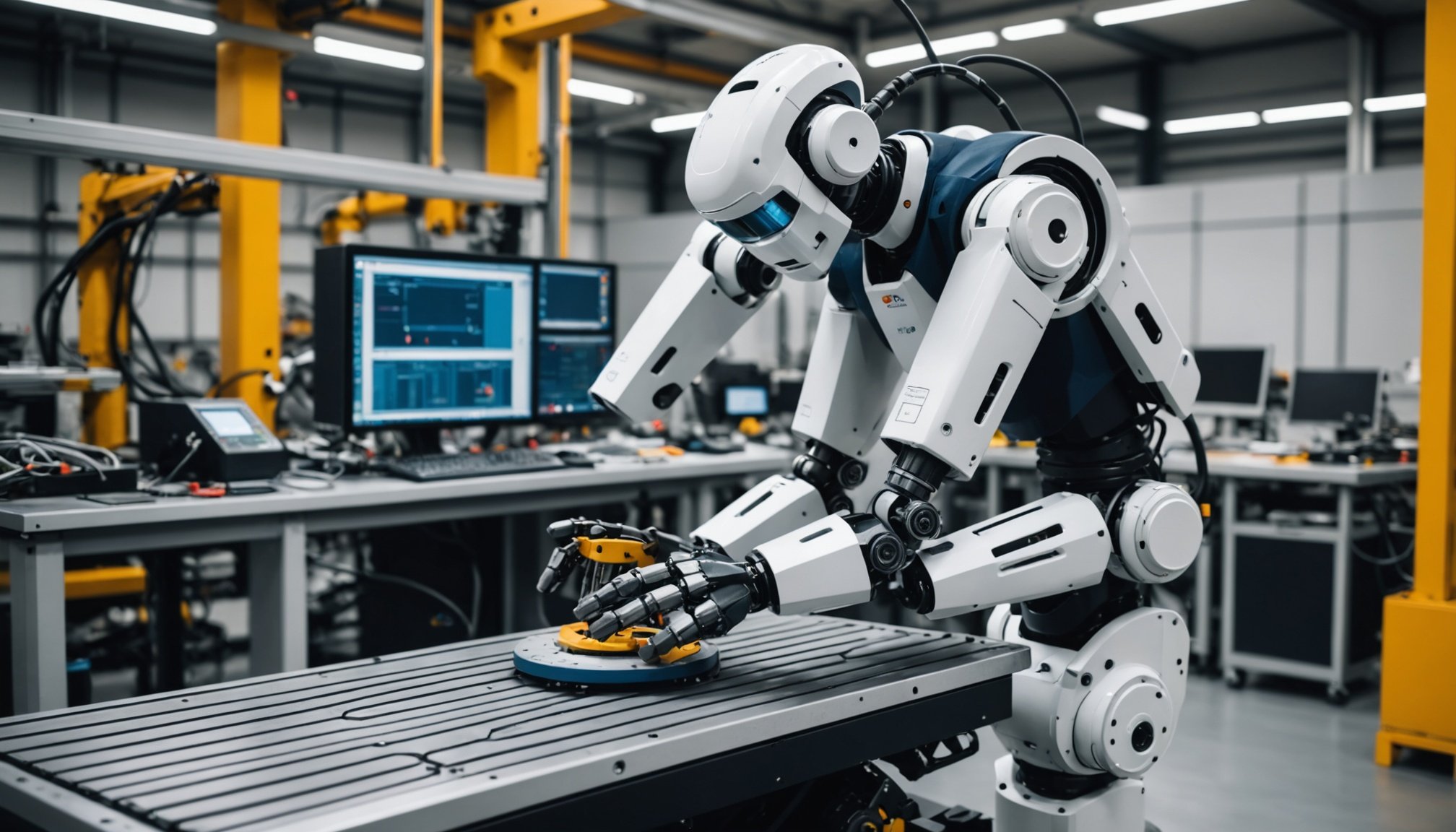Overview of Robotics in UK Manufacturing
The incorporation of robotics in manufacturing has significantly transformed the UK manufacturing landscape. Defined as the use of automated machines to perform tasks typically done by humans, robotics is integral in enhancing operational efficiency and productivity. As the demand for rapid production rises, manufacturers are increasingly turning toward automation in production. Robotics streamlines processes, ensuring precision and minimising human error.
Current UK manufacturing trends reveal a steady embrace of automated solutions. Industries utilise robotics technologies to improve production lines, reduce costs, and increase output without compromising quality. Automation in production allows for continuous operation, greatly beneficial in sectors requiring high volume and consistency.
Also read : Exploring the Future of Self-Driving Public Transportation in the UK: Innovations and Insights
Statistically, the UK has shown substantial growth in robotics adoption within its manufacturing sector. Reports indicate a surge in the deployment of robotic systems, driven by advancements in technology and a push for competitiveness on a global scale. This trend showcases the UK’s commitment to integrating robotics into its manufacturing processes, anticipating further innovations and efficiency gains. As these trends continue, the role of robotics in UK manufacturing is poised to expand, reshaping how industries approach production challenges.
Benefits of Robotics for Precision and Efficiency
Exploring the benefits of robotics within production lines reveals significant advancements in both precision and efficiency. Robotics applications have revolutionised industries by introducing a degree of precision that is often unattainable through manual processes. These robotic systems ensure meticulous attention to detail, which significantly enhances precision manufacturing. Complex tasks can be executed repeatedly with consistent accuracy, resulting in a dramatic reduction in human error.
Additional reading : Iranian resistance: unfolding the future of freedom in iran
Moreover, production efficiency is significantly boosted. Automation technologies streamline processes, enabling quicker turnaround times. This not only enhances throughput but also contributes to substantial time savings. Robotics systems work tirelessly without the need for breaks, leading to around-the-clock operational capabilities that human labor simply cannot replicate.
Another impactful contribution is cost savings. Although the initial investment in robotic systems might be substantial, the long-term financial benefits are profound. Companies observe reductions in waste, decreased labor costs, and improved product quality. Consequently, the enhanced quality directly impacts customer satisfaction, which can result in increased market share and profitability.
As industries embrace these robotic advancements, the move toward automation is seen not just as a technological evolution but a strategic necessity in competitive markets.
Technological Advancements in Robotics
Robotic technology has evolved dramatically, driven by breakthroughs in artificial intelligence and machine learning. These advancements are transforming sectors, with manufacturing seeing notable improvements. AI in manufacturing facilitates more efficient operations by enabling machines to learn from data, predict maintenance needs, and optimise production processes. Advancements in automation have contributed to this industry revolution, making operations faster and reducing human error.
Integrating the Internet of Things (IoT) with robotics creates smarter manufacturing solutions. This approach allows devices and systems to communicate, resulting in more coordinated and adaptive production lines. For instance, IoT-enabled robots can adjust in real-time to variations in demand or supply chain disruptions, enhancing overall efficiency.
Several case studies exemplify the successful implementation of these technologies. A notable example is a leading car manufacturer that improved its assembly line’s productivity by introducing AI-powered robotic arms. These robots can work collaboratively with human staff, reducing fatigue and improving safety. Moreover, by leveraging machine learning, they can anticipate potential faults, cutting downtime significantly. These instances underscore the transformative potential of robotic technology and AI in reshaping traditional manufacturing landscapes.
Challenges Facing Robotics in Manufacturing
Integrating robotics in manufacturing comes with several automation barriers. One major challenge is adapting existing production lines to incorporate advanced robotics. This often requires significant investment and time, posing a hurdle for many companies. Additionally, manufacturers grapple with maintaining productivity levels while transitioning to automated systems.
Another pressing issue involves the skills gap in the workforce. With the rise of robotics, there is a growing need for workers skilled in robotics programming, maintenance, and supervision. This skills gap poses a significant challenge as the current workforce may not have the necessary technical expertise, leading to potential employment displacement.
Safety and regulations also present a considerable challenge. Ensuring worker safety around robotic systems is paramount. Robotics integration requires strict compliance with safety standards and regulations, which can be both time-consuming and costly.
Addressing these manufacturing hurdles requires strategic planning and investment in workforce training and development. Companies may need to collaborate with educational institutions to ensure their workforce is equipped with the necessary skills. Therefore, overcoming these challenges involves not only technological adaptation but also a holistic approach to workforce development and regulatory adherence.
Future Trends in Robotics for UK Manufacturing
As we venture further into the future of robotics, several emerging trends are set to transform UK manufacturing. Experts predict that the next wave of robotic innovations will focus on creating more adaptable and flexible systems. This evolution aims to address the dynamic demands of modern manufacturing environments, ensuring that robots can seamlessly integrate into various production stages with minimal disruption.
A key trend in manufacturing trends is the shift toward robotics systems that can quickly pivot between tasks, responding to just-in-time production needs. This adaptability increases efficiency and reduces downtime, making the production process not only faster but also more cost-effective.
The innovation in production is also driven by sustainability and environmental considerations. Future robotics developments are expected to prioritise energy efficiency and recyclable materials, minimising the ecological footprint of manufacturing processes. Advancements in AI and machine learning will assist robots in optimizing resource use and reducing waste, aligning with the growing emphasis on sustainable practices.
As these trends unfold, manufacturers can expect to see robotic systems with enhanced capabilities that are environmentally friendly, versatile, and tailored to meet specific industry needs. These innovations promise a more efficient, sustainable future for UK manufacturing.
Case Studies of Robotics Implementation
Exploring the impact of robotics applications in manufacturing reveals compelling success stories. In the UK, leading manufacturers have harnessed robotics to significantly enhance their production processes. One notable example of these case studies in manufacturing is within the automotive sector, where precision and efficiency are paramount.
Through robotics, companies have observed tremendous gains in efficiency. Production lines have streamlined operations, reducing the time and cost associated with manual interventions. The precision improvements have not only lowered error rates but also ensured a consistently high-quality output. These successes are echoed in other industries, with manufacturers achieving remarkable results by leveraging technology.
However, the path to such achievements is filled with valuable lessons. Manufacturers learned the importance of careful planning and phased implementation when integrating robotics. This approach mitigates disruptions and enhances the success rate of deployment. Moreover, training personnel to adeptly manage robotic systems further unfolded possibilities for expanded use.
In analysing these success stories in production, other industries can gain insights into optimizing operations and achieving improved outcomes. Embracing these lessons offers a blueprint for smoother transitions into a technology-driven era, ultimately promoting growth and sustainability in manufacturing.
Conclusion and Key Takeaways
The summary of robotics impact reveals a profound shift in UK manufacturing, significantly enhancing both precision and efficiency. Robotics not only accelerates production rates but also minimizes human error, thereby transforming traditional manufacturing landscapes.
For manufacturers pondering the transition to automation, several key insights can serve as guidance. Primarily, incorporating robots can lead to substantial long-term cost savings, despite the initial investment. This transformation requires training and adaptation but promises improved output quality and consistency.
Looking ahead, the future of UK manufacturing seems increasingly intertwined with robotics. The adoption of these technologies is paramount to maintaining competitiveness in a global market. Robotics will likely continue to evolve, offering even more sophisticated solutions to complex manufacturing challenges.
As manufacturers explore these technologies, a strategic approach can maximize benefits. Prioritizing areas where efficiency gains are most needed and collaborating with technology providers can enhance the adoption process. By embracing robotics, manufacturers position themselves at the forefront of innovation, prepared to tackle future market demands more effectively. This culminates in a manufacturing environment where precision and efficiency are no longer aspirations but realities.











